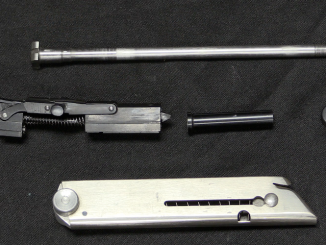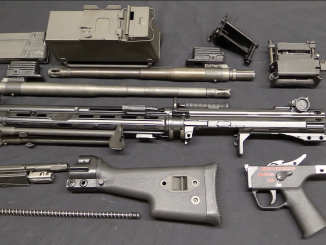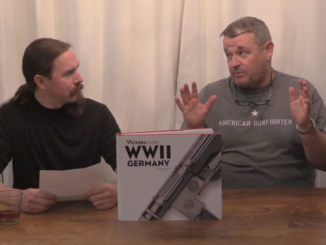When the German military first requested rifles in the new 8x33mm Kurz cartridge, there were two companies that provided designs. One was Haenel, who would eventually win the competition. The other was Walther, who submitted this rifle – the MKb-42(W). Where the Haenel gun fired from an open bolt and used a tilting bolt locking system, the Walther rifle fired from a closed bolt and used a rotating bolt to lock. It also used an unusual annular gas piston. In competition, the Walther’s closed bolt operation made it more accurate in semiauto fire and less susceptible to ingress of dirt. However, it was substantially more complex and more expensive that the Haenel gun.
In total, just 200 of the MKb-42(W) were made before being cancelled in late 1942. Needless to say, very few survive today, and it was a great privilege to be able to disassemble and present this one to you. Thanks to the Association of Maltese Arms Collectors and Shooters for the invitation to do so!




Very complicated considering they wanted to save money, and materiels. Horrible to field strip, and the hand guard must have got too hot to hold quite quickly.
I dont think material reduction were their goal around 1941, the shtf moments did not happen yet.
In outward it is somewhat similar to stg45, this centrally mounted barrel, round profile, and elevated sights, etc.
But magazine being so far from the grip makes it kinda ugly and off looking, imho.
Looking at pistol grip it reminds me about Pistole 35(p) (or in U.S. collector parlance RADOM automatic pistol), has anybody similar feeling?
Thanks for the detailed look at the Walther rifle, Ian.
I hadn’t realised you travel with your complete library, (well, it looks very similar to yours :-). I really liked the new Gothic, Hammer Horror-type location lighting in this video. It addded atmosphere.
I agree with your assessment that the out of battery safety looks like an afterthought, and iso a horrible, easily lost (and unlikely to be missed) part.
The auto sear is well capable of doing the job in semi auto, and in the Browning (ithaca) pump action shot gun, it even does the job in a manual repeater.
The manufacturing process flow sheet must have been fairly well established as well
A tab on the back of the machined bolt carrier and a matching tab on too of the hammer would have served to prevent the hammer from contacting the firing pin before the bolt was locked and the bolt carrier overtravel was at least partly complete.
The engineers were German (they had good brains) I can’t voucher for their managers (like Bubba, the pointy haired boss transcends all races, cultures and languages, and no gun is ever safe from his misplaced enthusiasm).
I’m guessing that the tooling and process flow sheet were too well advanced for changes to be made to the back of the bolt carrier and the hammer.
Ps
Biting get my tongue and typing fingers at the text to Ian’s right (Ian’s right, not ours).
“unusual annular gas piston”
This feature is mind boggling? Why they used it? By 1941 Germans conquered big part of Europe and also have used multiple captured weapons, including gas-operated with normal tubes, so they could be aware that such solution might work as intended. Was annular gas piston imposed by someone?
Is: “(…)This feature is mind boggling?(…)”
Should be: “(…)This feature is mind boggling for me.(…)”
Walther experimented with several different gas systems for rifles around that time. The Gewehr 41W used a muzzle cone/gas trap type system with a “sleeve valve” type piston, inherited from the experimental GA115 rifle of 1939-40. It was made in limited numbers for troop trials, parallel to the Mauser Gewehr 41M, and everybody agreed that it was a huge PITA to field-strip and clean, not least because it accumulated fouling faster than a conventional gas-piston system. (Not that the Mauser was any more popular; the complaints about both were loud enough that even the Gestapo couldn’t shut them up, according to W.H.B. Smith.)
After Barbarossa began, and captured Simonov and Tokarev self-loading rifles (analogues of the American Garand M1) began coming back from the Ostfront, Walther adopted the Tokarev-type gas piston system, except with the gas cylinder above the barrel rather than under it, a setup later to be seen on the Russian SKS and AK series rifles. The result was the Gewehr 43 and its later variant the Karabiner 43, which became the second-most-common self-loading rifles in the Wehrmacht inventory after the Haenel Maschinenkarabiner/ Sturmgewehr series (Mkb-42 to Stg-44).
As to which is which (G-43 or K-43), who knows? According to Smith, all G43/K43 rifles have the rail mount for the ZF-4 telescopic sight machined into the rear receiver, while “The hand guard may be wood or plastic, and the bolt carrier latch, which locks the bolt carrier and bolt to he rear, may be on the left or right side of the bolt carrier, or may not exist at all.”
If you’re confused too, join the club.
cheers
eon
“If you’re confused too, join the club.”
I would say I see two possible positive way to solve that problem:
– letter stamped on weapon determines if it is Gewehr or Karabiner
– all Gewehr become retroactively Karabiner and such all are Karabiner
–
Interestingly Soviets after encountering carbine-machine gun:
http://tankarchives.blogspot.com/2018/05/more-mkb42-impressions.html
(Haenel variant taking in account tilting bolt)
assumed it was weapon designed for fighting in forest environment, where sub-machine guns lacked penetration and machine guns [like MG 34] were awkward to use.
VHU PRAHA also has example of Maschinen Karabiner 42 (W), see photos:
http://www.vhu.cz/exhibit/nemecka-utocna-puska-mkb-42-w-maschinen-karabiner-42-w/
I understand description only partially, but it apparently say cartridge was developed by Polte, it also give technical-tactical requirements as follow:
barrel length: 400 mm
selective-fire
rate of fire: no more than 500 rpm
mass: no more than 4 kg
range: 800 m
If I am not mistaken 200 examples were ordered.
Most curiously, if I understand correctly, gas-system become failing [for what reason I don’t know. Maybe clogging?] after 50-100 shots.
Second information is mind catching by itself, but even more so if combined with earlier statements about 200 example ordered, as this spawn question: if its reliability was so low why they ordered 200 example? it is possible that this test run proved to be so unreliable as opposed to prototypes? if yes so why? was some heresy introduced when going from prototype to test samples? maybe prototypes were not tested extensively enough, for example against low temperature?
Technical technical data of Maschinen Karabiner 42 (W) sample hold by VHU PRAHA
Cartridge: 7,92 x 33 mm
Overall length: 944 mm
Barrel length: 405 mm
Sight radius[?]: 341 mm
Capacity: 30
Mass with empty magazine: 4950 g
Rate-of-Fire: 450…500 rpm
Now I found article in Russian about that weapon:
http://shooting-iron.ru/load/290-1-0-687
It states that at one point 200 example were required from Walther and 200 from Haenel, of their respective machine carbines, but give total production of Walther’s weapon as in area of 3 thousands, interestingly at some point following requirement were added: ability to mount bayonet, ability to use Schießbecher (grenade launcher, see photo in link), which delayed production. Unknown quantity of Walther’s and Haenel’s weapons were tested for battle testing in Eastern Front. Walther proved to be lighter, more compact and better balanced, which provided better results of fire, but at the same time it proved to be unsuitable for usage in harsh field conditions, so Haenel was chosen but at same time changes in Haenel were required.
Moreover, this article states that Walther started development after Haenel and was required to use magazine already developed (which would explain ability to swap), it also place in time line, start of works of Walther in end of year 1940, having late start might explain why they decided to use peculiar solution – to provide some advantages over Haenel.
The German military authorities had a horror of gas ports in design. Everywhere you look in early development, it is gas-trap at the muzzle and recoil operation. Part of this was fear that the gas port would be fouled to easily, and I’d wager good money that at least a part of that dual gas-port and annular piston stems directly from that fear.
You also get the sense that the design might have been influenced by the Browning shotgun designs.
Fouling was a big concern of the day. Add to that the corrosive residue left by the primers of the day, and you have a recipe for a rusted weapon that will blow itself to bits if not scrubbed free of muck and oxidation! And let’s not do a Private SNAFU by sticking the muzzle of this weapon in the mud.
“Fouling was a big concern of the day”
Wait, are there known examples of corrosive-primed German-made WWII-era Kurz cartridges? By that time I would except, if they introduce new cartridge it should be already non-corrosive (Sinoxid) primed. Did they used older priming mixture instead? If yes: why?
Sinoxid obviously does not totally remove need to clean weapon, but should made it at least bit easier.
Annular piston shows up in a few places the VZ-52 being the most obvious (to me). However, that trigger group…Anyone ever try to take apart a Marlin .22?
The “out of battery safety” was also present on the A115. In that video it was called a locking lug. This didn’t seem right, but having watched numerous, educational FW videos since then, out of battery safety makes much more sense. However the bolt has to be way out of battery because of the receiver cuts, that the hammer would hit the bottom of the bolt and not the firing pin and thus prevent out of battery ignition. Another thing the safety does does, is it slows the bolt down as the bolt moves forward. It also bears against the barrel extension when it is pushed in. Given the small bolt rotation, and German engineering I’d believe it was for controlling bolt bounce. IMHO.
There’s a functional example of this gun at Shrivenham. Some years ago, I had the opportunity to shoot it – see photo on page 11 of this: http://quarryhs.co.uk/GPC.pdf
Big question:
Who designed the magazine ?
Since the same one was used in all Walther and Haenel early prototypes and finally Stg/mp44.
If article I linked earlier http://shooting-iron.ru/load/290-1-0-687 is true in that regard, then magazine was developed by (or at least for) Haenel, and it was ready when Walther started developing own weapon and simply used this ready part.
Article give following dates:
18 April 1938 – agreement between C.G.Haenel and HWaA for new weapon firing short cartridge
early 1940 – first working prototype is delivered to HWaA
late 1940 – agreement between Walther and HWaA for weapon with same technical requirement as in earlier agreement, but with one additional: use magazine already developed
Thanks for info.
Why I asked – because I think it is a troublesome magazine (as one article here that Ian posted some years before analyzed),
so its suprising they all used the same one with no upgrades; ok, walther added that experimental bolt open feature in it, but everything else is the same.
I hope Ian will touch ak47 mag one day, I’m fascinated how it is a trouble free affair compared to some submachine magazines where it is a customary for some having bad reputation mostly due to the mags (sten etc.), yet in assault rifles that is not so frequent case! (well, m16 was apparently, here and everywhere else like youtube there are nutheads mentioning often spectre m4 and skorpion in n64 game Goldeneye; now its my turn of geeky moment by mentioning probably overlooked classic game, FPS “Vietcong” that had realistic weaponry of the era, including in last levels mattel marvel M16, loaded with only 18 rounds in magazine (!).
In first ones you blasted “commie pigs” with PPSh, SKS and Thompson, and even end up crawling like rat through the cramped VC tunnels with legendary “hush puppy” pistol – try out the game, its good (because it was made by european developer, and not some USA politically correct hypocrites)
“(because it was made by european developer, and not some USA politically correct hypocrites)”
Well, and in Europe (more precisely Germany) there is:
https://www.polygon.com/2017/10/29/16566774/wolfenstein-2-censorship-in-germany-video
which reminded me about one video:
https://www.youtube.com/watch?v=33Zp3BXwDB8
Hmmm, its puzzling how it is allowed to sell there at all, since it is borderline perverse situation of modern germans playing a game in which you symbolically kill your own nation, germans, possibly their grandfather generation.
And with extreme 3d reality looks these days, it is far cry from cartoonish 30×20 pixels characters of first wolfenstein 3d, where you needed to use good bit of your imagination to percieve that pixelated, half recognizeable crude images seen on low res monitor as fearsome nazis.
So that could also be the reason for extreme censorship, not just shame but some degree of rudimentary pride also.
Hi Ian. Extremely informative and interesting video as always. I’ve learned a lot from your detailed reviews over the years. For your consideration, I offer I different interpretation of the primary function of the spring-loaded bar on the top of the bolt. I think it is primarily to keep the bolt in the forward position while it is pushing a cartridge out of the magazine and into the chamber. Every gun that locks with a cammed turning bolt needs something to prevent the bolt from turning while it is being used to push a cartridge and before it is ready to turn into battery. The AK has a flat spot in the cam track, the AR has the cam pin ride along a horizontal track, and the AUG has a conceptually similar spring-loaded part which is similarly pushed out of the way when it is time for the bolt to turn into battery. Without this functional feature a cammed turning bolt not be able to fully chamber a round and go into battery because it would already be turned (pushed back) and mis-aligned with the opening in the locking lugs. I do not question that it enhances safety to prevent the firing pin from protruding from the bolt face before the bolt is in battery, but I think the spring-loaded bar on the MKb-42(W) bolt is primarily there to enable to gun to function. Best regards, Christopher
EXCELLENT, THANK YOU ! Another tip, if you don’t see Lifeframe in all programs (because mine didn’t) just type it in and it will come up on the top in a box that doesn’t look like it’s clickable, but click it. Once it opened, I right clicked the icon and pinned it to my task bar so I don’t have to hunt it down any more.